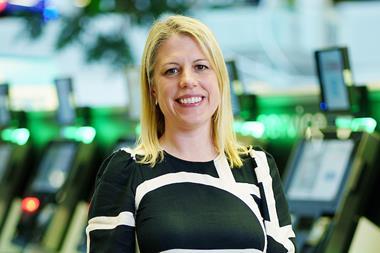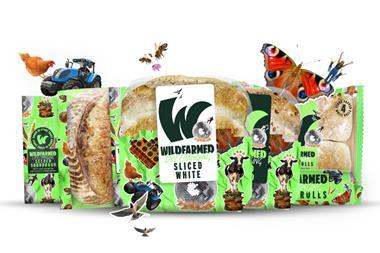A CONVENIENT CONCEPT
The enticing smell of crispy, freshly baked baguettes and rolls meets early shoppers in the refurbished Co-op Late Shop in Buckingham Road, Cheadle.
With fresh blue and green fascia and fittings, a clean layout and bread and pizza cooked on the premises, the Late Shop is a far cry from the typical corner shops of the past.
Buckingham Road is one of United Norwest's five concept stores at which it is testing out new convenience retailing ideas. The first pilot store in Offerton has been a phenomenal success, so the society is now testing variations on the Offerton theme in its concept stores.
Convenience retailing has overtaken the supermarket side of United Norwest's business, says Martin Flaherty, general manager of the convenience group. Turnover and profits from the convenience stores were about 30% higher than for supermarkets last year, he says, and that should continue to occur as the group expands.
Flaherty already manages 294 stores and an "ambitious acquisition programme" will bring many more into the fold over the next couple of years, hence the importance of getting the look and feel of the shops just right.
At the moment, the c-stores are made up of 201 Late Shops and 26 Village Stores. In addition the society is converting the Hanburys, Nevans and Dawn til Dusk stores it has bought, plus the 16 outlets bought from Spar retailer Alfred Jones. The long-term plan is to integrate all of the businesses under the Late Shop or Village Store concept, but it's an expensive business.
Over the next six months, Flaherty expects to spend about £10m on the store development programme. Stores in good condition will be left in their current incarnations until they can be fitted into the ongoing refurbishment programme. Flaherty hopes to have a good third of the estate converted to the new format by the end of the year, with the rest completed within two or three years.
A model store has been developed, taking the best elements from each of the five concept shops, and all redevelopment will be based on a version of that model.
One element likely to be carried into the new stores is food to go. It has taken off in Offerton, says Flaherty, although it is very labour intensive. A simplified version might be more suitable, he says, providing what the customer wants without the labour costs of the current food to go service.
"We've got different types of food to go in each store, so we'll assess which is working best," he says.
Of course, it's not just the look of the store that matters: hundreds of new staff are being brought on board each year. Flaherty faces a huge human resources challenge in making all these people feel and act like part of the Co-op team. "A personnel team goes out as soon as there's an acquisition to do a welcome on board' and tell them about the benefits of joining," he says. "In a group acquisition, we'll take them all off site to a hotel and get the management team to talk with them. We want them to feel at ease from day one."
Plenty more new United Norwest staff will be joining in the next year or two. The acquisitions team has a target of between 25 and 30 single store acquisitions for next year "perhaps where people want to retire from a business and already have half their minds in the Bahamas," says Flaherty plus any group purchases it can find.
Every retail group has its own acquisition team, Flaherty says, "so the trick is to get in first".
The major multiples have moved into the convenience market over the past few years because they recognise how shopping habits have changed, he adds. "And having taken up most of the out of town sites available, they're looking back to the high street for new opportunities."
E-commerce is less of a threat to convenience retailing than to supermarkets, says Flaherty, and could actually open up opportunities. "People may do their whole week's grocery shopping online, but they'll look to us for fresh food, milk and so on."
Rather than unifying under one fascia, United Norwest will stick with its current brands, Late Shop and Village Store, he says, because they are suited to different areas.
Each store fits one of four United Norwest cluster groups, depending on the local demographics and the position of the store. A village centre, for example, may fit a different cluster to a shop in a housing estate. Each cluster group has a varying product range that best suits the local needs.
Different branding can also help when stores are close together, says Flaherty. "If, for example, we have a Village Store in the centre of a village and a Late Shop just outside with longer hours, you avoid the question why are there two Late Shops within a mile of each other?'," he says.
By the end of 2002 United Norwest plans to have converted all of its c-stores to one of its new formats. "By then I'm sure we'll have new thinking and will want change," says Flaherty. "That's progress."
{{Z SUPPLEMENTS }}
Close menu
- Home
- Buying & Supplying
- Stores
- Channels
- Finance
- People
- Reports
-
Events
- Back to parent navigation item
- Events
- The Grocer Gold Awards
- LIVE: Retail Week x The Grocer
- The Grocer New Product & Packaging Awards
- The Convenience Awards
- The Convenience Conference
- Rethinking Materials
- Food & Drink Expo
- Farm Shop & Deli Product Awards
- Farm Shop & Deli Retailer Awards
- The Omnichannel Conference
- Jobs
- Subscribe now
UNITED NORWEST SUPPLEMENT
2000-05-27T00:00:00+01:00
Sign in to comment on this article
Not logged in before? Register for FREE guest access today.
You will be able to:
- Read more stories
- Receive daily newsletters
- Comment on stories
Advert








No comments yet